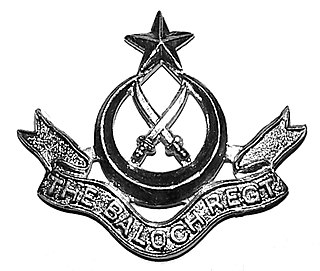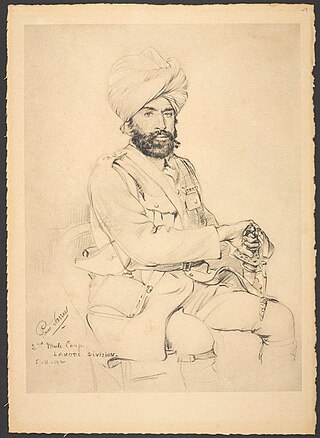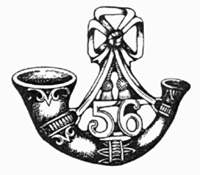| British Indian Army | |
|---|---|
| Allegiance | |
| Type | Army |
| Size | 2.5 million men (1945) |
| Engagements | Second Afghan War Third Afghan War Second Burmese War Third Burmese War Second Opium War 1882 Anglo-Egyptian War 1868 Expedition to Abyssinia First Mohmand Campaign Boxer Rebellion Tirah Campaign British expedition to Tibet Sudan Campaign World War I Waziristan campaign 1919–1920 Waziristan campaign 1936–1939 World War II North West Frontier |
| Commanders | |
| Notable commanders | Herbert Kitchener, 1st Earl Kitchener William Slim, 1st Viscount Slim Archibald Wavell, 1st Earl Wavell Claude Auchinleck |
The Commander-in-Chief of India, Lord Kitchener carried out a reform of the British Indian Army in 1903. These reforms were intended to improve the Army, which had been formed from the separate Bengal, Bombay and Madras presidency armies in 1895 to be replaced by the Bengal, Bombay, Madras and Punjab commands. The localisation of regiments was abolished, and in future every regiment was to have the opportunity of experiencing service on the Frontier.
Contents
- Cavalry
- Bodyguard troops
- Former Bengal Regiments[7]
- Former Punjab Regiments[8]
- Former Madras regiments[9]
- Former Hyderabad regiments[10]
- Former Bombay regiments[11]
- Former Local Corps[12]
- Cavalry and Infantry
- Infantry
- Former Bengal Regiments[14]
- Former Punjab Regiments[21]
- Former Madras Regiments[23]
- Former Hyderabad Regiments[24]
- Former Bombay Regiments[25]
- Former Local Corps[29]
- Gurkha Line[30]
- Support Arms
- Indian Mountain Artillery
- Engineers
- Services
- Imperial Service Troops
- Volunteer Corps
- Cavalry 2
- Artillery
- Engineers 2
- Infantry 2
- Frontier Corps and Para-Military Units
- North-West Frontier and Baluchistan
- North-East Frontier and Burma
- Units formed in World War I
- Cavalry 3
- Artillery 2
- Infantry 3
- Paramilitary
- See also
- Footnotes
- References
- Online
To signify the unification of the three presidency armies, regiments in all Corps were assigned new designations with distinct numerals. The Bengal, Madras, and Bombay Sappers and Miners were numbered consecutively, with presidency names removed. Cavalry regiments were numbered as follows:
- Bengal regiments retained their existing numbers.
- 20 was added to the numbers of Punjab regiments. The word 'Punjab' was replaced by 'Frontier Force'.
- 25 was added to the numbers of Madras regiments.
- 1st, 2nd, and 4th Regiments of Cavalry, Hyderabad Contingent were re-numbered as 20th, 29th and 30th.
- 30 was added to the numbers of Bombay regiments.
- The Central India Horse regiments were brought into the line with 37 added to their numbers.
Infantry regiments were numbered as follows:
- Bengal regiments retained their existing numbers. As the 9th, 42nd, 43rd, and 44th regiments were Gurkha Rifle regiments, they were transferred to the Gurkha Line as 9th, 6th, 7th and 8th Gurkha Rifles. Their places were filled by infantry units from Local Corps.
- 50 was added to the numbers of Sikh Infantry regiments.
- Punjab regiments, less the 5th Gurkhas, were numbered consecutively as the 55th to 59th; so that, for example, the 2nd and 4th Punjab Infantry became 56th and 57th respectively. The word 'Punjab' was replaced by 'Frontier Force'.
- 60 was added to the numbers of Madras regiments (53 to that of the 25th regiment of Madras Infantry). The 10th regiment was transferred to the Gurkha Line as the 10th Gurkha Rifles. The remaining Burma regiments were renamed as Punjabis (except the 33rd, which became 93rd Burma Infantry). Regiments which recruited from north-western India were renamed as Punjabis, while those recruiting from southern India were renamed as Carnatic Infantry.
- 93 was added to the numbers of Hyderabad Contingent regiments.
- 100 was added to the numbers of Bombay regiments. [1]
By 1903, the total strength of the Indian Army was 240,000 men. [2] They served in 39 cavalry regiments, 135 infantry battalions (including 17 Gurkha), [2] a joint cavalry-infantry unit the Corps of Guides, three sapper regiments and 12 mountain artillery batteries. [3] In addition to the regular Indian Army, the armies of the Princely states, and regiments of the Auxiliary force (European volunteers) could also be called on to assist in an emergency. [3] The Princely states had 22,613 men in 20 cavalry regiments and 14 infantry battalions. [4] The Auxiliary force could field another 40,000 men in 11 regiments of horse and 42 volunteer infantry battalions. [2] Also available were the Frontier Militia and the Military Police, which could field 34,000 men between them. [2]











